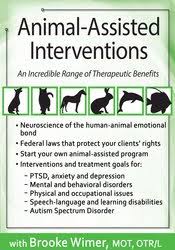Brooke Wimer – Animal-Assisted Interventions: An Incredible Range of Therapeutic Benefits
$200 Original price was: $200.$75Current price is: $75.
Shopping Instructions:
- DISCOUNT 15% : SHOP15
- Product Delivery: Within 1 – 12 hours after purchase.
You will receive specific examples of animal-assisted therapeutic goals in a variety of functional areas. You will develop a toolbox of animal-assisted interventions and animal-focused treatments you can employ the very next day.
Brooke Wimer – Animal-Assisted Interventions: An Incredible Range of Therapeutic Benefits
A toolbox of interventions for clients diagnosed with:
- Trauma, anxiety, depression and PTSD
- Mania and psychotic disorders
- Conduct and antisocial personality disorders
- Cognitive disorders, dementia and stroke
- Behavioral and personality disorders
- Intellectual and learning disabilities
- Physical and occupational disabilities
Join animal-assisted therapy expert Brooke Wimer, MOT, OTR/L, and learn how incorporating animals into your professional activities can greatly improve client outcomes in a surprisingly broad range of areas, including:
- Reduce stress and anxiety levels and lower blood pressure
- Lessen feelings of loneliness and poor self-esteem in those with trauma and anxiety
- Treat symptoms in people dealing with depression and PTSD
- Develop empathy in those with conduct disorder and antisocial personality disorder
- Improve physical function in people recovering from a stroke
- Improve reading and comprehension in children with learning disabilities
- And more!
You will receive specific examples of animal-assisted therapeutic goals in a variety of functional areas. You will develop a toolbox of animal-assisted interventions and animal-focused treatments you can employ the very next day. This seminar also includes the latest research outcomes and a solid foundational knowledge about the human-animal emotional bond. You will also discover very practical information and resources to help you develop programming and implement your own animal-assisted interventions.
OUTLINE
Brief Overview
- Human-animal emotional bond
- Therapy animal vs. service animal
- Animal-assisted therapy, activities and education
- Handler vs. clinician, clinician-animal teams
- Animal-based interventions without an animal
Mindfulness of Animals and How it Helps the Human Brain
- The neuroscience of the human-animal bond
- Why zebras don’t get ulcers
- Benefits of owning a companion animal
Interventions and Treatment Goals/Outcomes
- Mental, cognitive, emotional, and behavioral issues
- Increase attendance and engagement in sessions
- Treat symptoms related to trauma, anxiety and depression
- Decrease loneliness and improve self-esteem
- Develop empathy and encourage outward focus
- Provide hope, meaning and purpose
- Challenges with learning
- Improve reading and comprehension
- Support vocabulary development
- Increase verbal interactions
- Physical and occupational issues
- Progress fine and gross motor skills
- Improve sitting/standing balance
- Increase endurance and activity tolerance
- Facilitate improved sensory processing
Components of Animal-Assisted Intervention
- Selecting appropriate recipients for care
- How to approach clients
- Interaction techniques for client and animal
- Closure, documentation
Start Your Own Animal-Assisted Program
- Animal qualifications and characteristics
- Qualifications for clinicians
- Preparing and caring for the animal
- When the animal shows signs of stress and agitation
- Protecting your practice through risk management
- Organizations and resources for starting your animal-assisted program
Would you like to receive Brooke Wimer – Animal-Assisted Interventions: An Incredible Range of Therapeutic Benefits?
OBJECTIVES
- Identify evidence-based research outcomes regarding animal-assisted interventions.
- Implement animal-assisted interventions for people with mental health disorders including anxiety, depression, bipolar, schizophrenia and personality disorders.
- Design animal-assisted interventions to increase language and literacy in children with learning disorders.
- Design animal assisted interventions to address physical and occupational challenges.
- Employ animal-assisted interventions as a modality to treat people with dementia and other cognitive disorders.
- Apply knowledge to design your own animal assisted programming.
- Explain the difference between a therapy animal, a service animal and an emotional support animal
Related products
HEALTH & MEDICAL
HEALTH & MEDICAL
CC11 Workshop 06 – Magical Moments in Couples Therapy – Jette Simon
HEALTH & MEDICAL
Matthew Troester – How Much Sleep Do We Need and How to Get It
HEALTH & MEDICAL
Bernadette Giorgi – Attitude Ballet & Pilates Fusion – Just B Method
HEALTH & MEDICAL
Dr. J.E. Williams & Kevin Gianni – How to Read Your Blood Tests
HEALTH & MEDICAL
Gaia—Creating-High-Voltage-Health-with-Glenn-Streeter-Open-Minds
HEALTH & MEDICAL
HEALTH & MEDICAL
KettleWorX – 8 Week Rapid Evolution Advanced Set with Alex Isaly












